Lord Shiva (full) information (facts) (details) – Part 1 of 2
Namaste friends, how are you doing today? Welcome to #BhagavanBhakthi website / blog.
Bhagavan Lord Sri Vishnu (Krishna), Goddess Lakshmi, Lord Shiva and Goddess Parvati blessings to you and your family!
In this website / blog, you will always learn about #Hinduism #Sanskrit language.
Also subscribe to my YouTube channel from this link #BhagavanBhakthi to view videos about #Hinduism #Sanskrit language.
Just before going to “Lord Shiva (full) information (facts) (details) – Part 1 of 2“, let us know a brief, basic and very important information.
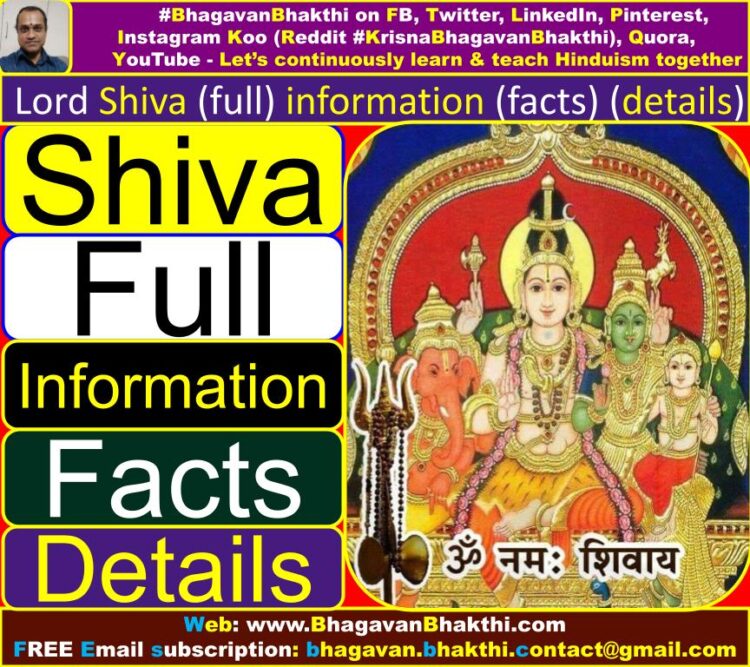
Common questions asked regarding this subjects are as given below:
What are facts about Shiva | How was Lord Shiva born? | What is the full name of Shiva? | Lord shiva history | Signs that Lord Shiva is with you | Lord Shiva age | And many more…
Lord Shiva’s consort (wife) name is Goddess Sri Parvati Devi and he has two children and their names are Lord Ganesha and Lord Kartikeya.
Lord Ganesha’s different names are Vinayaka, Lambodara, Ekadanta, Vikata, Sumukha, Balachandra, etc. Lord Kartikeya’s different names are Skanda, Subramanya, Murugan, Shanmukha, Kumara, etc.
Information about when to observe Maha Shivaratri is as given below:
It has to be observed on Magha Masam (month), Krishna Paksha, Chaturdashi Tithi. But that Chaturdashi day should be ‘vidda’ (overlap) with trayodashi tithi (day).
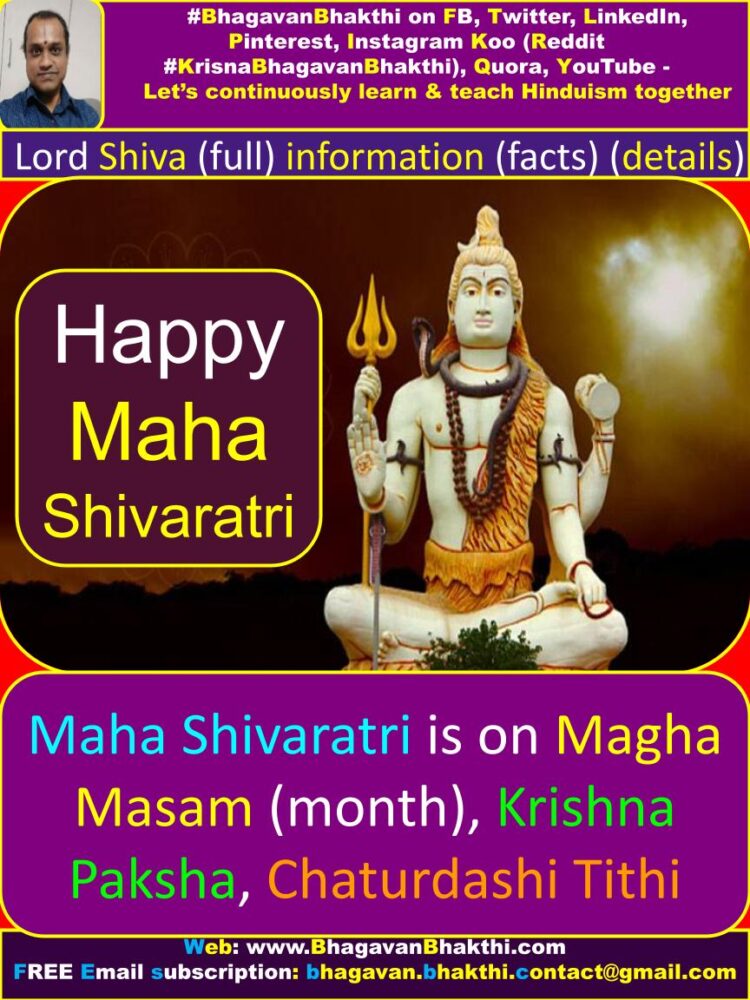
Lord Shiva (Lord Sri Rudra Deva) has 28 sallakshanas (सल्लक्षण) (sallakṣaṇa) (Auspicious qualities).
Lord Shiva is the abhimani devata (controller god) for Ahankara tattva (अहंकार तत्त्व) (ahaṅkāra tattva).
Lord Shiva will be reborn as Lord Sri Adishesha Naga, that is, bed of Lord Sri Vishnu in his next life.
Information about how to meditate upon (chintana krama) Lord Shiva is as given below:
ध्येयः पञ्चामुखो रुद्र: स्पटिकमाल कान्तिमान्। विद्युच्छभ्रासितराज: श्या मान्यस्य मुखानि तु | जाटावब बद्धेन्दुकाल: प्रियायुक् नागभूषण: |
ಧ್ಯೇಯ: ಪಂಚಮುಖೋ ರುದ್ರ: ಸ್ಪಟಿಕಮಾಲ ಕಾಂತಿಮಾನ್ । ವಿದ್ಯುಚ್ಛಭ್ರಾಸಿತರಾಜ: ಶ್ಯಾಮಾಂಯಸ್ಯ ಮುಖಾನಿ ತು | ಜಟಾವಬದ್ಧೆಂದುಕಾಲ: ಪ್ರಿಯಾಯುಕ್ ನಾಗಭೂಷಣಃ |
dhyēya: pan̄camukhō rudra: spaṭikamāla kāntimān | vidyucchabhrāsitarāja: śyāmānyasya mukhāni tu | jaṭāvabad’dhendukāla: priyāyuk nāgabhūṣaṇaḥ |
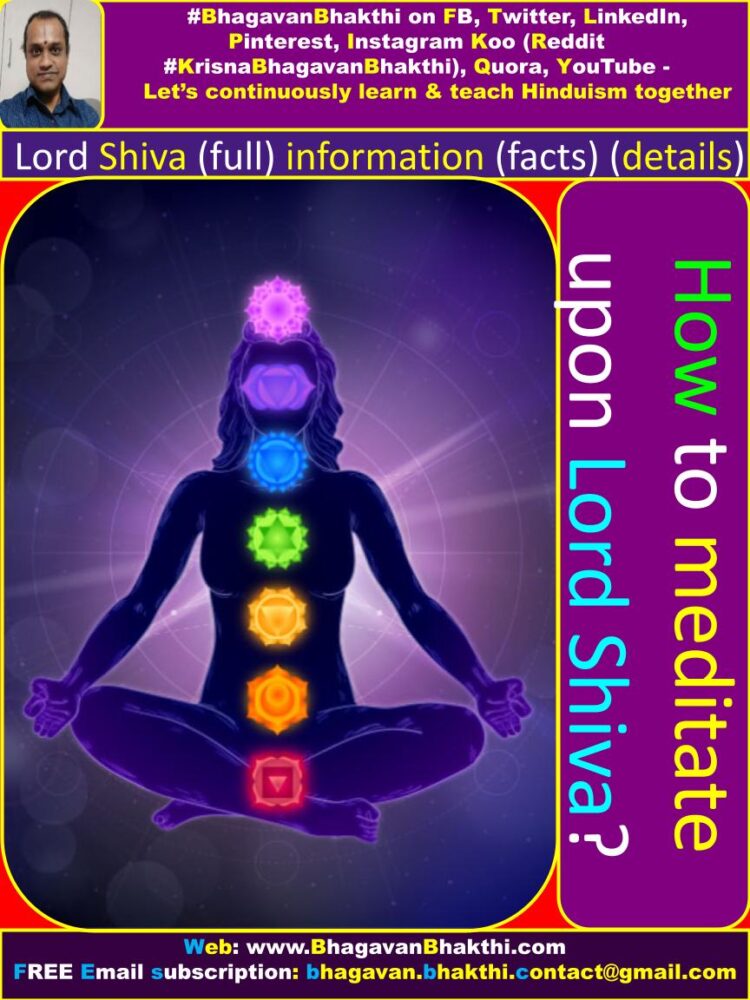
Meaning of this above shloka : Lord Sri Rudra Deva (Lord Shiva) has five faces – the colour of body looks like a spatika stone. Lord Sri Rudra (Lord Shiva) Deva has Chandra in his Jata (matter hairs).
Lord Sri Rudra Deva (Lord Shiva) is sarpabhooshana (having serpent on his neck). Goddess Sri Parvati Devi will always be with Lord Sri Rudra Deva (Lord Shiva).
Lord Sri Rudra Deva (Lord Shiva) has Goddess Sri Ganga Devi in his jata (matted hairs), that is, it’s the Lord Sri Maha Vishnu’s paadodaka (water from foot) on his head.
Lord Sri Rudra Deva (Lord Shiva) has three eyes on all his five faces. Lord Sri Rudra Deva (Lord Shiva) always has Urdwapundra, shanka Chakra symbol on his body.
Lord Sri Rudra Deva (Lord Shiva) has Padmakshi Tulasimala on his body. In his four hands Lord Sri Rudra Deva (Lord Shiva) has shoola, varamudra, abhayamudra, and deer.
The names of Lord Sri Rudra Deva (Lord Shiva) five faces are tatpurusha, Aghora, sadyojata, vaamadeva and Ishana.
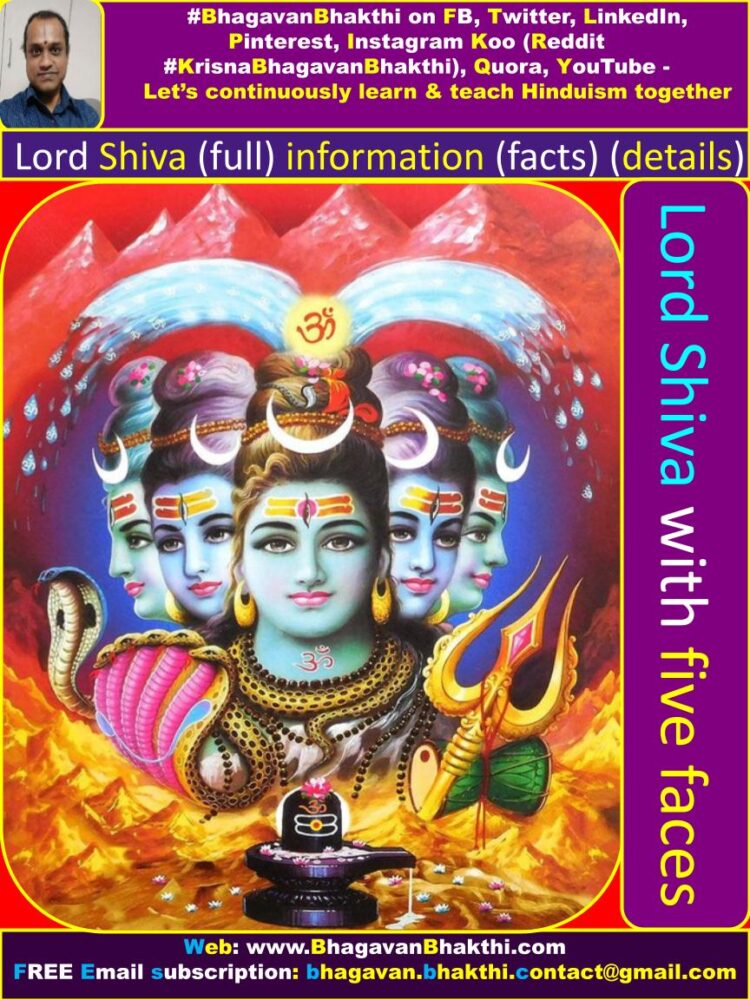
Sri Madhwacharya Ji has given “Shiva panchakshara Mantra” in Tantrasaara sangraha, i.e., “Om namaha shivaya” (ॐ नमः शिवाय) (ōṁ namaḥ śivāya).
Lord Shiva likes “Somavara” (सोमवार) (sōmavāra) (Monday). Lord Shiva is abhisheka priya (like the abhisheka).
Lord Shiva likes बिल्व पत्र (bilva patra) Bilva (Bael) patra (leaves). Thus, the archana (pooja) of Lord Shiva has to be done with Bilva (Bael) patra (leaves).
Information about birth of Lord Shiva is as given below:
Lord Sri Brahma Deva first did the सृष्टि (sr̥ṣṭi) (creation) of अज्ञान (ajñāna) (ignorance), मोह (mōha) (infatuation), महामोह (mahāmōha) (Greater ignorance), तामिस्र (tāmisra) (Taamisra), and हतामिस्र (hatāmisra) (Hataamisra).
Lord Sri Brahma Deva also created Sanaka Kumara, Sanandana Kumara, Sanatana Kumara and Sanata Kumara and asked them to increase the human population.
Together all the four Kumaras (Kumars) are called as ‘Sanakaadi‘ (Sanakaadi = Sanaka + Adi = Sanaka Kumara + others).
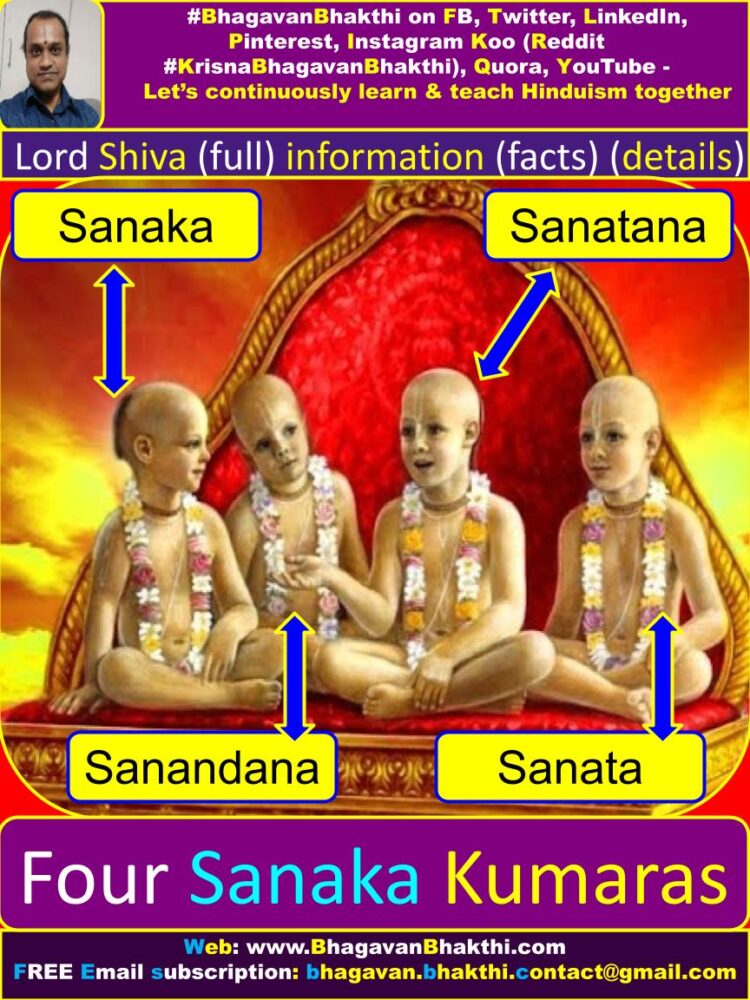
But these Kumaras refused to do so, and told that they shall be आजन्म ब्रह्मचारी (ājanma brahmacāri) (aajanma brahmachaari), that is, “living without marriage from birth until last breath“.
Hearing this, Lord Sri Brahma Deva expressed anger at this, but could not resist the anger.
Thus, a baby boy was born through the centre of भृ (bhr̥) (bhru) / मूर्धन (mūrdhana) (mUrdhana) (forehead) of Lord Sri Brahma Deva.
As he was born immediately he was called as सद्योजात (sadyōjāta) (Sadyojata), and as his eye brows were black and had read eyes and thus he was called as नील लोहित (nīla lōhita) (Neela Lohita).
At the same time that baby boy was crying very loudly and for this reason, that baby boy was called as Rudra, this means, रोदनात रूद्र (Rodanaat rudra) (rōdanāt rudra).
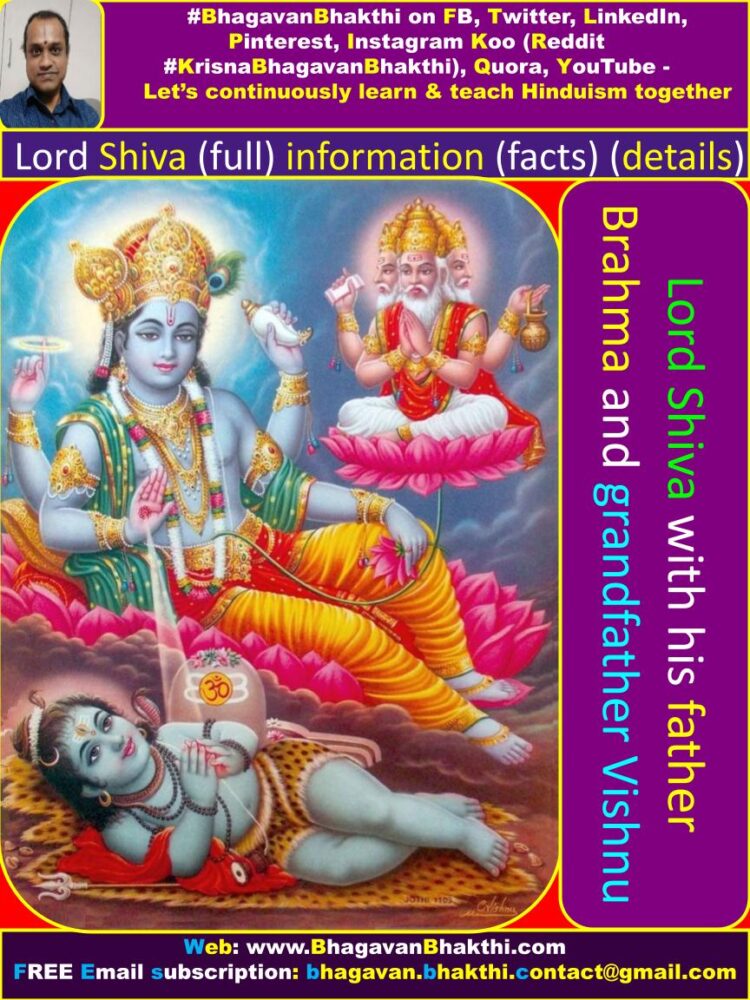
Information about Lord Shiva and Daksha Prajapati Yagna is as given below:
Daksha Prajapati is the son of Lord Sri Brahma Deva and is also the father-in-law of Lord Shiva.
Daksha Prajapati had given his daughter Goddess Sri Sati Devi (earlier life of Goddess Sri Parvati Devi) to Lord Shiva.
Daksha Prajapati did Satra Yagna (a sacrifice), wherein he had invited all the Devatas (Demigods) and had the blessings of almost all the Rishis (Sages), Kinnaras, Kimpurashas, etc.
In the assembly, Lord Sri Brahma Deva was sitting and similarly Lord Shiva was also sitting alongside Lord Sri Brahma Deva.
When Daksha Prajapati entered the assembly, he did सास्टांग नमस्कार (sāsṭāṅga namaskāra) (Saastaanga Namaskaara) to Lord Sri Brahma Deva, his father.
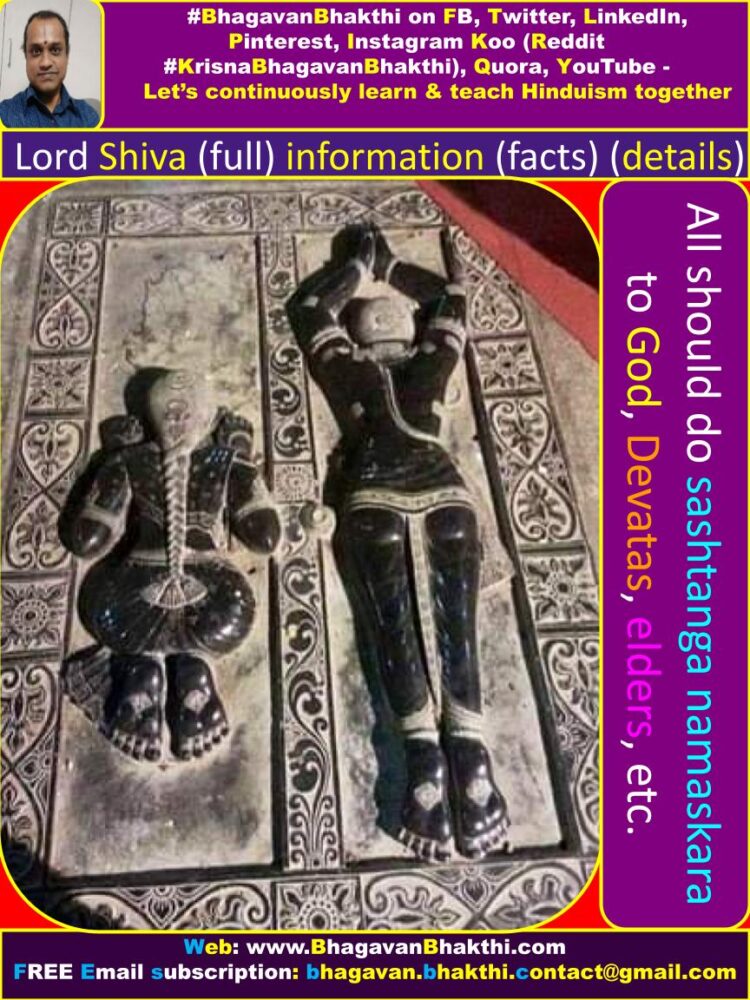
Whereas, Lord Shiva didn’t do नमस्कार (namaskāra) (namaskaara) to his father-in-law, that is, to Daksha Prajapati.
Actually Lord Shiva need not have respected Daksha Prajapati, as Daksha Prajapati is in the lower hierarchy Devatas level compared to Lord Shiva.
Lord Shiva had done the नमस्कार (namaskāra) (namaskaara) to Lord Sri Brahma Deva and as he (Lord Shiva) was in deep meditation of Lord Sri Vishnu, he (Lord Shiva) did not got up and could not notice anyone except Lord Sri Vishnu at that time.
Due to this Daksha Prajapati got angry towards Lord Shiva.
For this reason, Daksha Prajapati in the assembly, insulted Lord Shiva by saying that –
“Lord Shiva’s eye resembles the eye of a monkey and that even though he does not deserve, he had given his daughter Goddess Sri Sati Devi in marriage to Lord Shiva”.
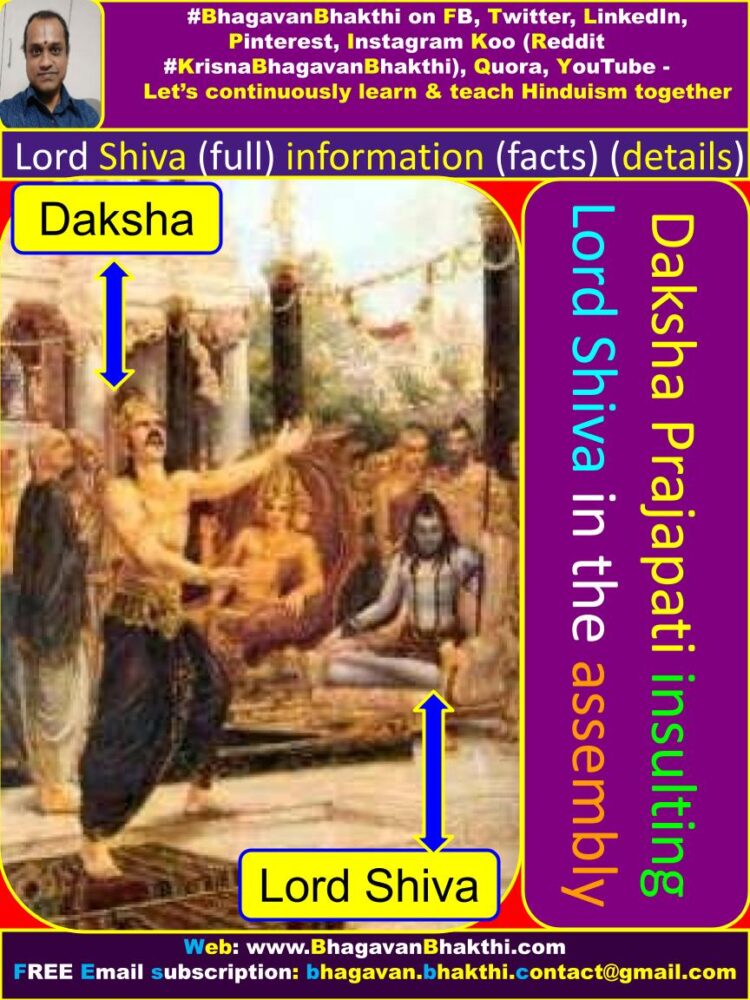
Daksha Prajapati also insulted that “Lord Shiva is a Digambara, he (Lord Shiva) is occupied by boota gana, always wanders in Ghats (smashana) (cemetery),”
“he (Lord Shiva) does snaana (bath) with the ash of the dead, he (Lord Shiva) is amangala (inauspicious)” and cursed that “Lord Shiva shall not Havis of Yajna in future“.
On hearing the curse by Daksha Prajapati, Lord Shiva also cursed Daksha Prajapati that, “you will loose यतार्थ ज्ञान (yatārtha jñāna) (yataartha Jnaana) (real and correct knowledge) and you shall have the face of a sheep“.
Lord Shiva also cursed to all the Brahmins that, “the Brahmins who all earn the wealth in the form of money, vidya, tapas, vrata (vrat) shall be utilized for daihika kaama (once own pleasure)“.
This enraged Maharishi Bhrigu, who in turn also cursed that – “those who does the pooja – vrata to please only Lord Shiva shall be away from Sachchaastra Shravana,“
“such kind of people will be away from shuchitva (cleanliness), do the Dharana (apply) of bhasma of dead“.
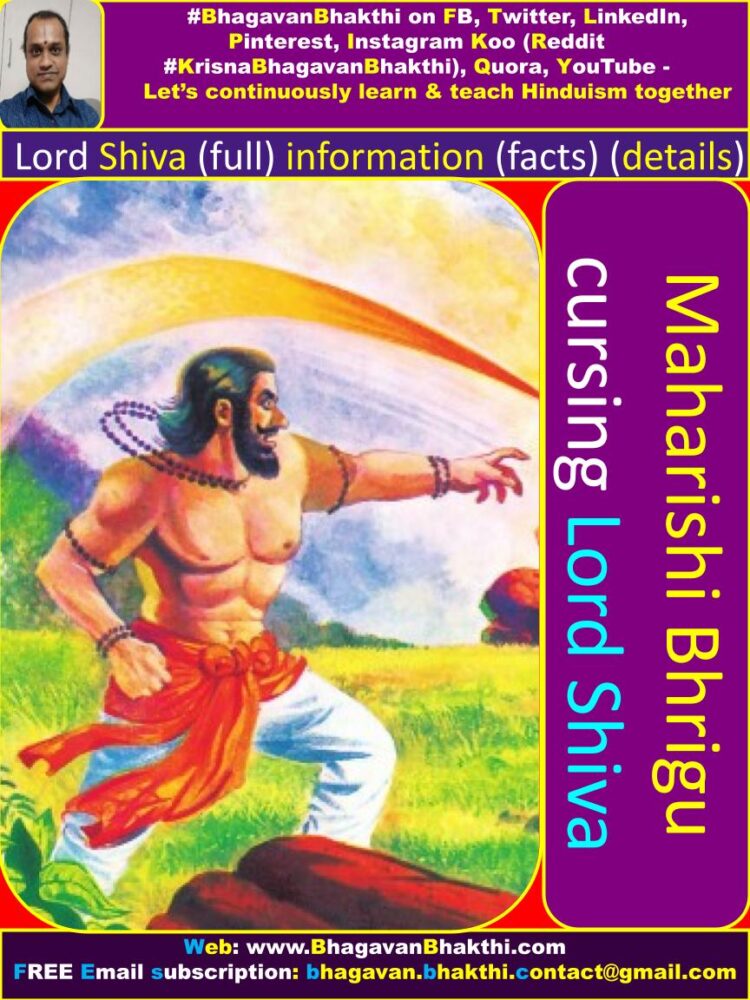
[Here “Sachchaastra Shravana” means hearing / knowing the right information about Hindu Texts.]
Maharishi Bhrigu continued with his curse as, “such kind of people shall be far away from Vedas, and that they shall become paashandi (heretic)“.
After the completion of Yagna (Satra) which lasted for thousands of years – all the Rishis (Sages), Devatas (Demigods), etc. left that place.
But the enmity between the father-in-law (Daksha Prajapati) and son-in-law (Lord Shiva) continued.
Lord Sri Brahma Deva also named Daksha Prajapati as the “अधिपति (adhipati) (head) of all the Prajapatis”, which increased the “Aham” (ego) in Daksha Prajapati.
After some time, Daksha Prajapati decided to do one more yajna named “Brihaspati Savam”.
This is a Maha Yajna, wherein he invited all Brahmarshis, Pitrus, Devatas (Demigods), Gandharvas and the entire family of Devatas (Demigods).
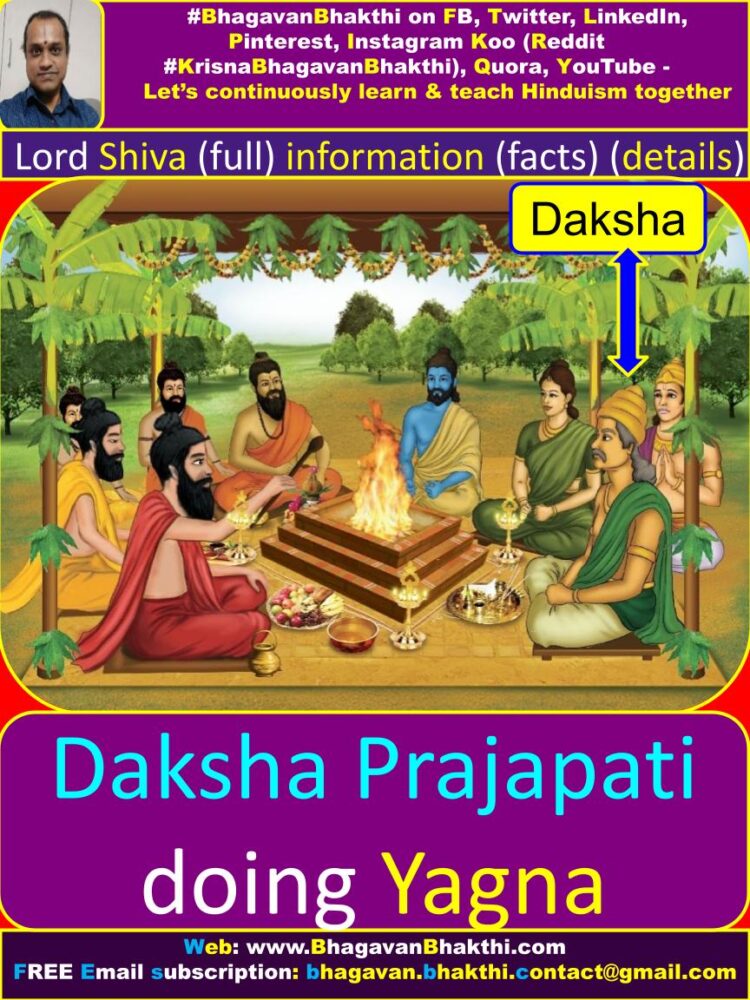
Daksha Prajapati refused to invite his daughter Goddess Sri Sati Devi, and her husband Lord Shiva for the Yajna.
But Goddess Sri Sati Devi wished to attend the Brihat Yagna (very huge sacrifice) and pleaded Lord Shiva to come.
But Lord Shiva told that as they are not invited for the yagna, it is not good to attend the function.
Goddess Sri Sati Devi told that for going to her father’s house, there need not be invitation.
Lord Shiva replied that Goddess Sri Sati Devi is right in her intention to attend her father’s yagna, if he (Daksha Prajapati) had no enmity with us, but as he hates us and as he does not have the characters of sajjana purusha, it is not good to attend the yagna.
But Goddess Sri Sati Devi insisted that she definitely will go to Daksha Prajapati’s Yajna.
Lord Shiva told that he will not come. But Goddess Sri Sati Devi went alone herself sitting on Nandi to the Daksha Prajapati’s Yajna.
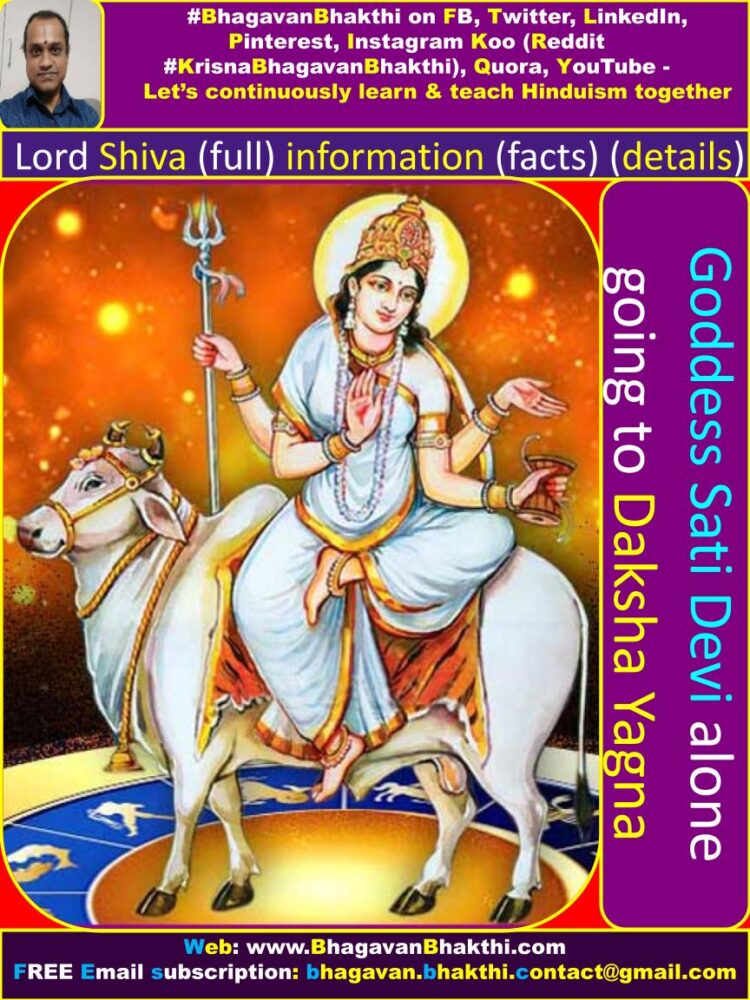
Goddess Sri Sati Devi was followed by thousands of Lord Shiva’s bhoota ganas and sainikas.
In the assembly, no one did respect Goddess Sri Sati Devi except her sisters and her mother.
Even her father Daksha Prajapati didn’t even bother to speak to Goddess Sri Sati Devi.
In the Yagna, Goddess Sri Sati Devi noticed that Lord Shiva is not given the Havis and that his father is insulting Lord Shiva.
Goddess Sri Sati Devi repented for having born as the daughter of Daksha Prajapati.
And Goddess Sri Sati Devi thought that she shall never be called as दाक्षायणी (dākṣāyaṇī) (Dakshayani) (daughter of Daksha) and entered Agni (fire) and did the shareera tyaaga (physically sacrificed her life).
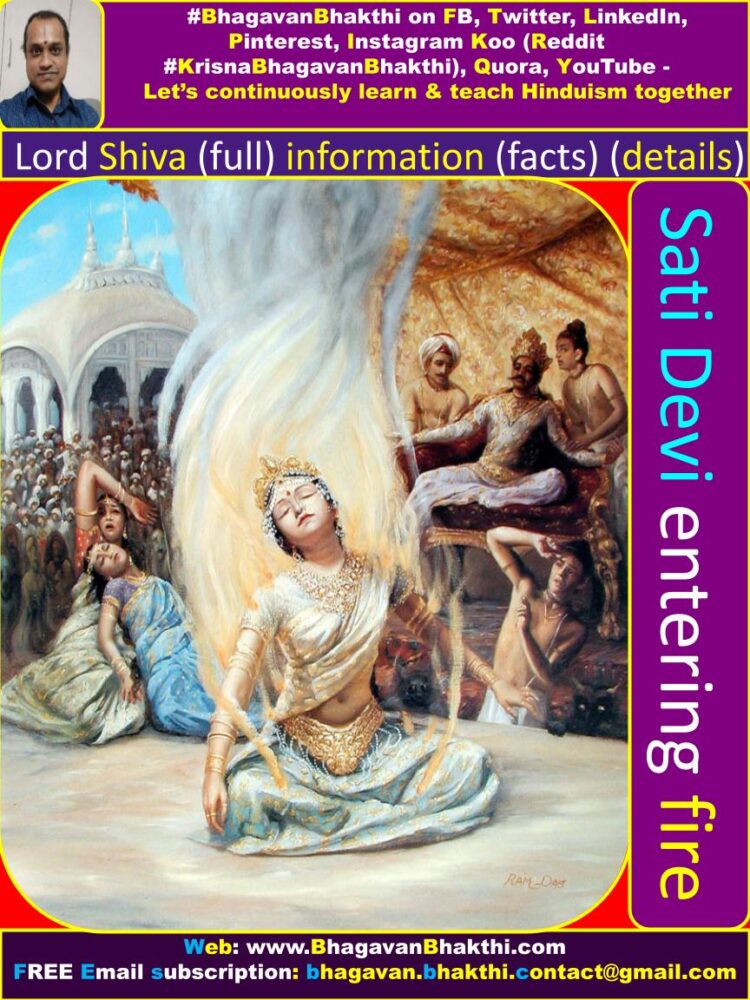
Now, Daksha Prajapati started feeling guilty of his sins.
On seeing Goddess Sri Sati Devi entering the agni (fire), Lord Shiva’s soldiers who had accompanied Goddess Sri Sati Devi tried to kill Daksha Prajapati and also tried to destroy the Yagna.
Maharshi Bhrigu did special आहुति (āhuti) in Dakshinaagni from Yajurveda mantras.
With the special आहुति (āhuti), Brahmana’s power i.e., Rubhu Devatas came in the form of weapons and attacked the Lord Shiva’s soldiers who later had to ran away.
Here Lord Shiva at Kailasha (Kailash), on hearing the incident that happened in the Daksha Prajapati’s Yagna, created Veerabhadra (Virabhadra) and Shivaanucharaas (Lord Shiva’s soldiers) out of his Jata (matted hairs) and asked them to destroy the Yagna.
These Shivaanucharaas (Lord Shiva’s soldiers) attacked the entire Yagna assembly and destroyed everything there.
Veerabhadra (Virabhadra) removed the mustache of Maharshi Bhrigu, and removed both the eyes of Bhaga and the teeth of Poosha.
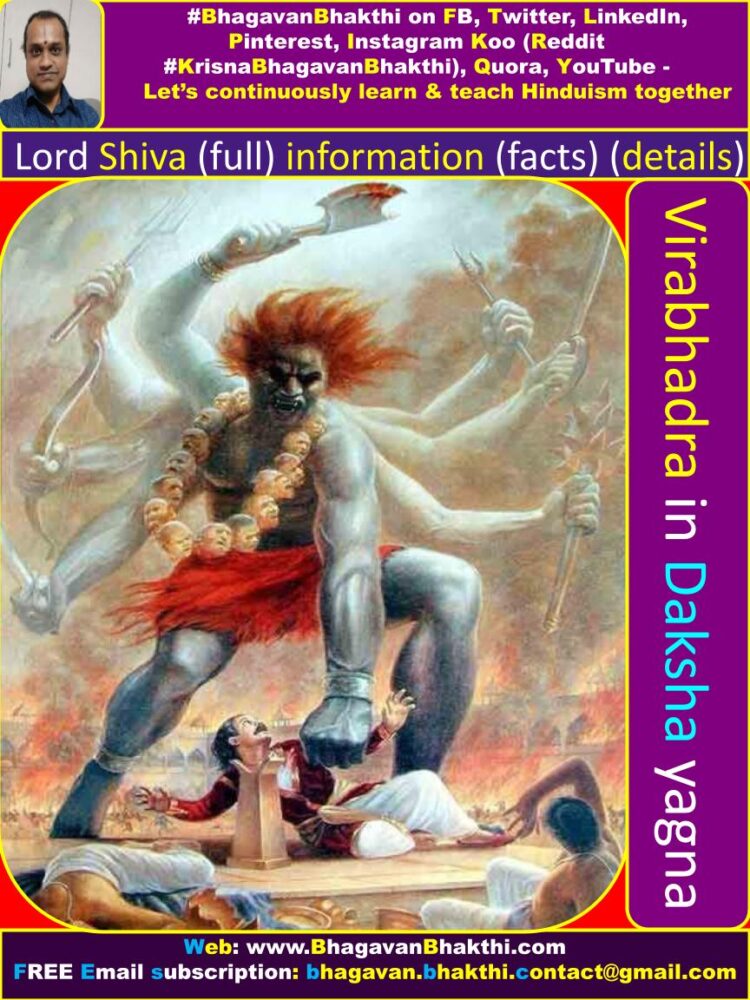
Veerabhadra (Virabhadra) tried to remove the head of Daksha Prajapati but failed, then he did the meditation of Lord Shiva, who came immediately and removed the head of Daksha Prajapati.
All Devatas (Demigods) approached Lord Sri Brahma Deva to control Lord Shiva.
With the blessings of Lord Sri Brahma Deva, Lord Sri Rudra Deva’s (Lord Shiva) anger was reduced and he completed the Daksha Prajapati’s Yagna after adding the head of sheep to the body of Daksha Prajapati.
Now it is the turn of Daksha Prajapati begs for pardon from Lord Shiva for having committed one of the biggest sins of his life.
[Source – Srimad Bhagavata Purana, Chaturtha (4th) Skanda.]
Information about Ilavrata Khanda & Rudra is as given below:
In Ilavrata Khanda (a place), only Lord Shiva is the purusha (male) and all others are strees (women).
As per the curse by Goddess Sri Bhavani Devi, all who enters this place shall become women automatically.
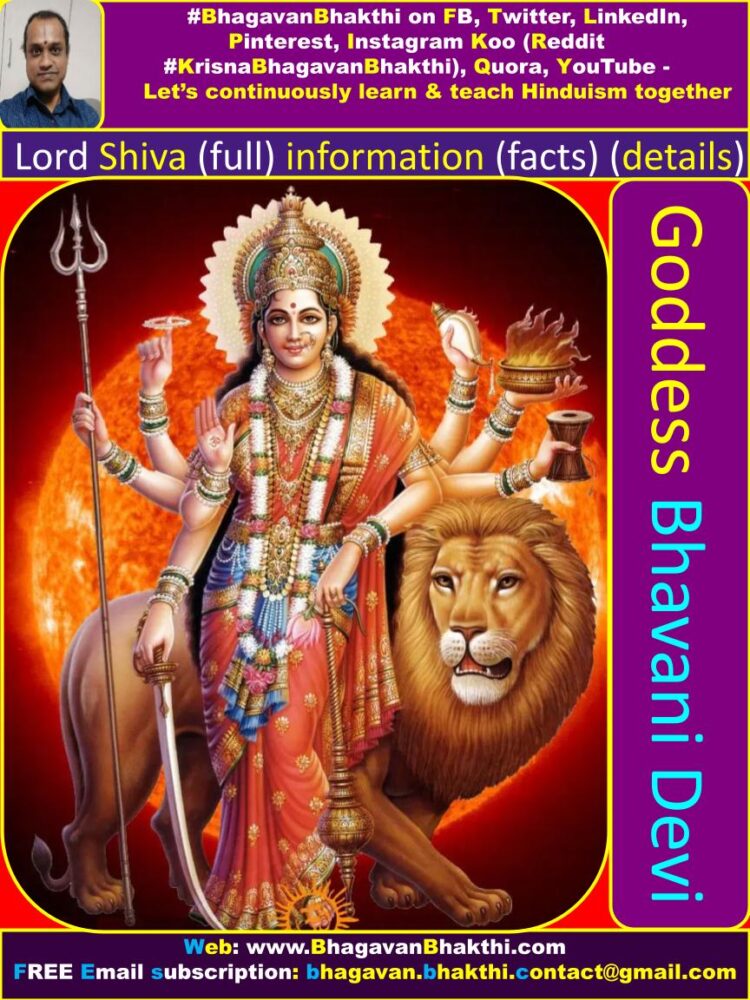
Here Lord Shiva will be doing the dhyana (meditation) of ‘Sankarshana roopa Paramatma‘ (Lord Sri Vishnu in his Sri Sankarshana form).
Information about Tripurasura samhaara (Slaying) is as given below:
Tripurasura – Here Tripurasura means three demons, that is, namely Vidyunmali, Tarakaksha and Kamalakshya.
All these three demons were the sons of another demon called Tarakasura (Tarakasura was killed by Lord Kartikeya / Skanda – son of Lord Shiva and Goddess Sri Parvati Devi).
After the killing of the demon Tarakasura by Lord Kartikeya (Skanda), these three sons did a severe penance to please Lord Sri Brahma Deva and asked for the अमरत्व (amaratva) (immortality).
This was refused by Lord Sri Brahma Deva saying it can’t be given by him. Then they (3 demons) planned and sought another boon seeking three different cities made of Gold, silver and iron respectively, and that three cities align once in thousand years.
And these forts (inside the cities) were built in different worlds shall align once in every 1000 years. These combined forts were called as Tripura.
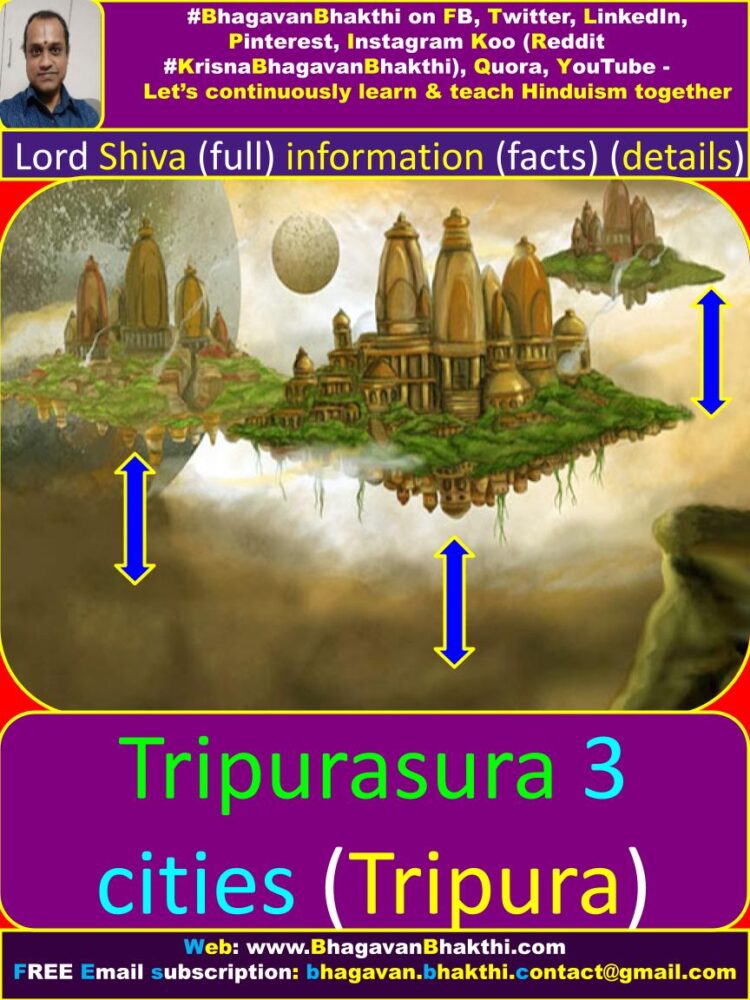
And if anyone can then destroy Tripura with only a single arrow that shall be the death for all three of them.
Lord Sri Brahma Deva granted this rare boon and Maya (demons’ engineer) built three forts, that is, the golden fort in Svarga Loka, the silver fort in the aakasha / sky and the iron fort on earth.
For the Golden City Tarakaksha was the king. For the Silver City Kamalaksha was the king and, for the Iron City Vidyunmali was the king.
Good words of Maya (Demon’s engineer architect) to Tripurasuras:
The three brothers were the kings of three cities created by Maya (rakshasa shilpi – engineer architect among the demons).
Maya built these cities with the power bestowed by Lord Sri Brahma Deva as a special power on him (Maya). Maya is the demon architect and it is his duty to build whatever the demons ask for.
But, we should also remember that Maya (Demon’s engineer architect) although a demon, but he was also a satvika jeevi (Someone who follows Dharma correctly).
Along with the three cities, Maya also built Lord Shiva’s temple in the Golden city of Tarakaksha. Maya was giving many satvika upadeshas (good words / preaching) to the three brothers and his subordinates.
[The upadesha prabhava (influence of preaching) which Maya gave was there for these subordinates even during the Lord Buddha avatar].
Maya understood that Kali (Kali Yuga’s Kali) and Alakshmi (Kali’s wife) had entered the forts, but he could not save these demons.
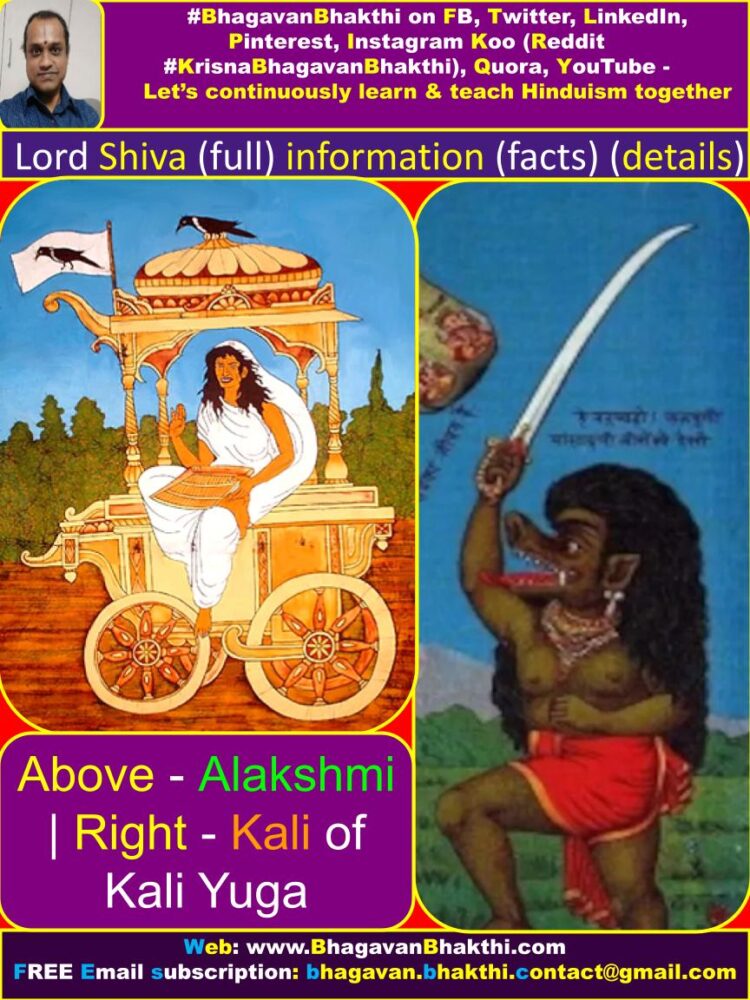
Hari (not Lord Hari / Vishnu, but a demon with the same name Hari), the son of Tarakaksha did penance for Lord Sri Brahma Deva and sought the construction of ‘Mrita sanjeevani canal‘, which Lord Sri Brahma Deva granted.
Those who were killed were immersed in the ‘Mrita sanjeevani canal’ and they used to get back life with enhanced powers.
Lord Sri Indra Deva, Lord Sri Surya Deva and other Devatas (Demigods) attacked Tripurasuras (the three asuras), and no one could win them as all those who die would be brought back to life by immersing them in the ‘Mrita sanjeevani river‘.
Later, all the Devatas (Demigods) went to Lord Sri Brahma Deva, whereas Lord Sri Brahma Deva sent them all to meet Lord Shiva.
Lord Sri Brahma Deva also went with the other Devatas (Demigods) to meet Lord Shiva and told him to kill all the Tripurasuras.
[Here, by seeing some of the Puranas, one may think that Lord Sri Brahma Deva is obeying to Lord Shiva, as he also went to meet Lord Shiva and pleaded for killing of the demons.]
[But one must always remember that Lord Sri Brahma Deva did it for ‘asura jana mohanaarta‘ (to show illusionary path to demons).]
[But actually Lord Sri Brahma Deva was praying to Lord Sri Vishnu who is present as antaryami inside Lord Shiva.]
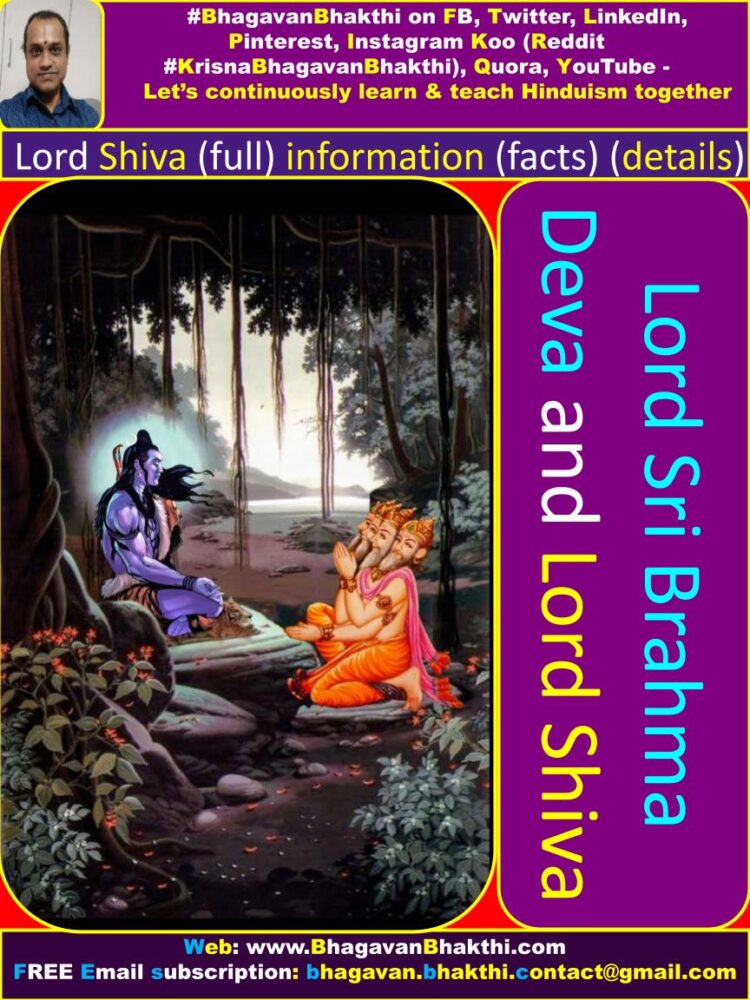
Lord Shiva told all the Devatas (Demigods) to give their half of the powers to him (Lord Shiva), so as to enable him to kill the three demons (Tripurasuras), which they did as per the request.
The Devatas (Demigods) arranged for a beautiful Chariot, built by Vishwakarma (Deva Shilpi / Demigod’s engineer architect), wherein Lord Sri Brahma Deva himself stood as Lord Shiva’s charioteer.
(Again we need to remember that Lord Sri Brahma Deva is the father of Lord Shiva and is at the higher position than Lord Shiva.)
(For example in Mahabharata Lord Sri Krishna becomes the charioteer of Arjuna. This doesn’t means that Arjuna is greater than Lord Sri Krishna).
One arrow was built with the power and presence of Lord Sri Vishnu, Lord Sri Soma (Chandra) (Moon God)) and Lord Sri Agni Deva (fire God) in the arrow. Lord Sri Vishnu was at the edge of the arrow.
Lord Shiva told Devatas (Demigods) that his charioteer shall be supreme than him. As such, Lord Sri Brahma Deva agreed to become charioteer for the chariot.
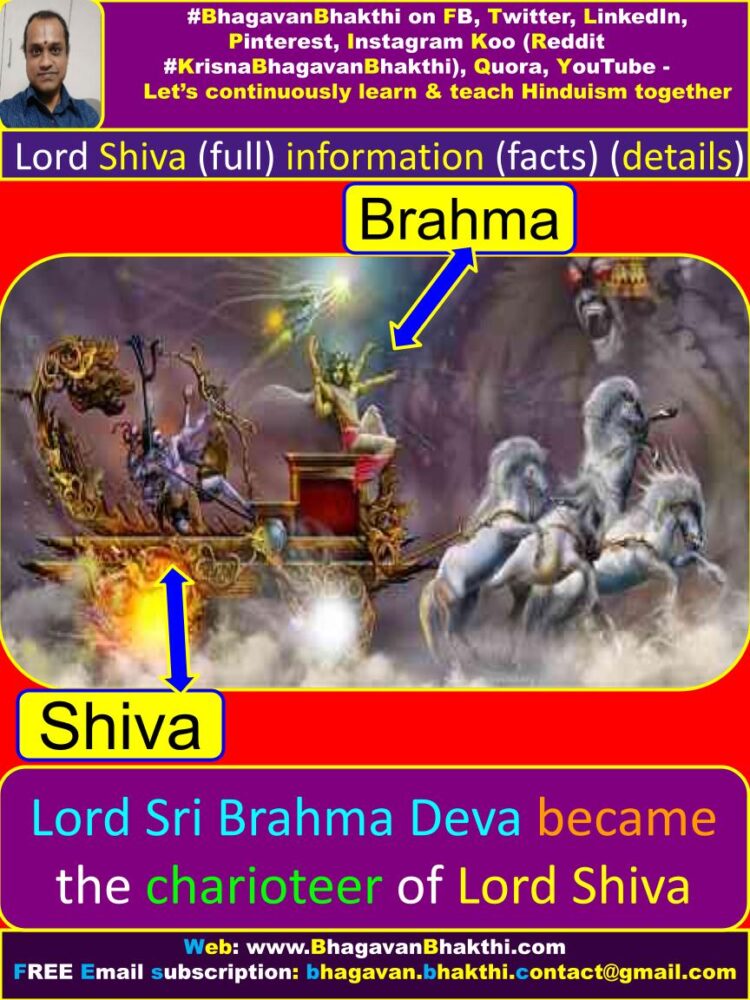
Lord Shiva waited for the occasion, that is, when all the three of their (Tripurasuras) Lokas come in the same line.
Immediately Lord Shiva entered the battlefield, the three forts were about to merge into a single line, (this was the condition) and would last for just a second, which will happen once in thousand years.
At this exact time, Lord Shiva used the most destructive weapon controlled by him, the पाशुपतास्त्र (pāśupatāstra) (Pashupatastra) and killed the Tripurasuras (3 demons) and Tripura (their three cities).
Thus, Lord Shiva killed all these three demons with the help of Lord Sri Brahma Deva and Lord Sri Vishnu. Lord Shiva proved the boon given by Lord Sri Brahma Deva by killing the three asuras (demons) in a single arrow.
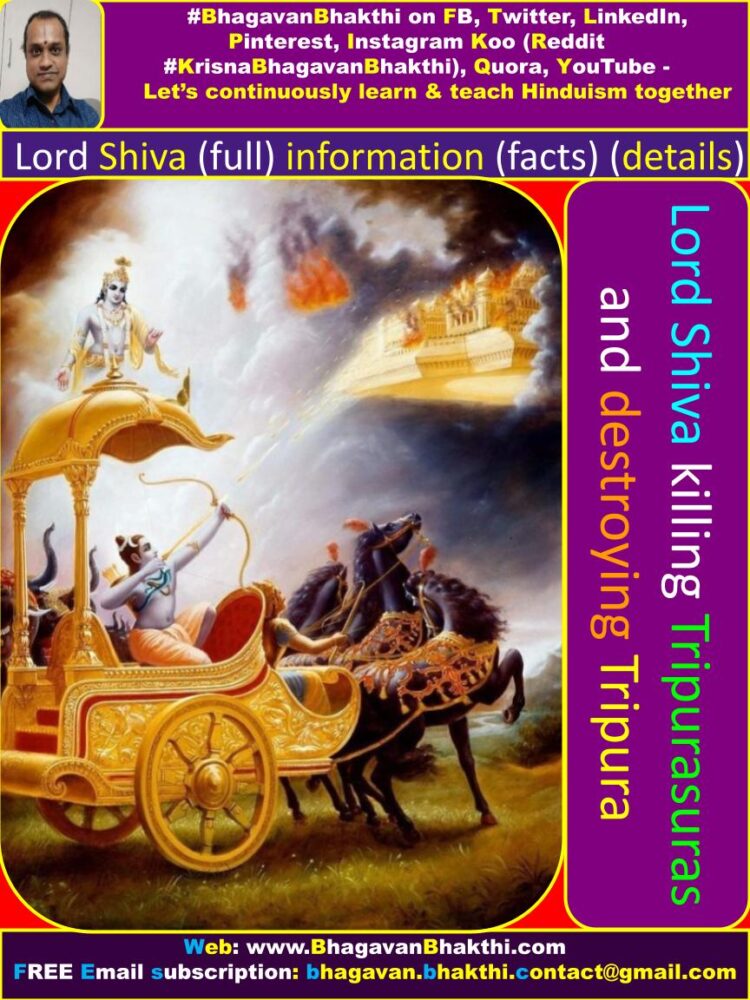
Thus Lord Shiva got the name त्रिपुरान्तक (tripurāntaka) (Tripurantaka) (someone who killed the three asuras / demons and three cities).
The form which Lord Shiva took for killing of Tripurasuras and Tripura is called as अघोरा (aghōrā) (Aghora).
The story of killing of Tripurasuras is called as रुद्र विजय (rudra vijaya) (Rudra Vijaya). Those who read this story, listen this story will get “vijaya” (victory) would be blessed by Lord Shiva (Lord Sri Rudra Deva).
Further it is also good to hear the ‘Tripurasura samhara‘ (killing of all the 3 demons) story during Shraddha time as it earns sarva yagna phala (all the fruits of sacrifice). (This is as per Matsya Purana).
Information about Lord Shiva prays to Lord Sri Rama for samapti (end) of his Lord Sri Rama avatar is as given below:
As Lord Shiva is the grandson of Lord Sri Vishnu, all the Devatas (Demigods) prayed Lord Shiva to plead with Lord Sri Rama to leave bhuloka (earth).
Lord Shiva pleaded that the ‘avatar karya‘ (avatar works) in ‘dushta shikshana and shishta rakshana‘ (To punish the evil and to save the Dharmic people) has been completed and it is the right time to come back to Vaikuntha, an ultimate abode of Lord Sri Rama (Vishnu).
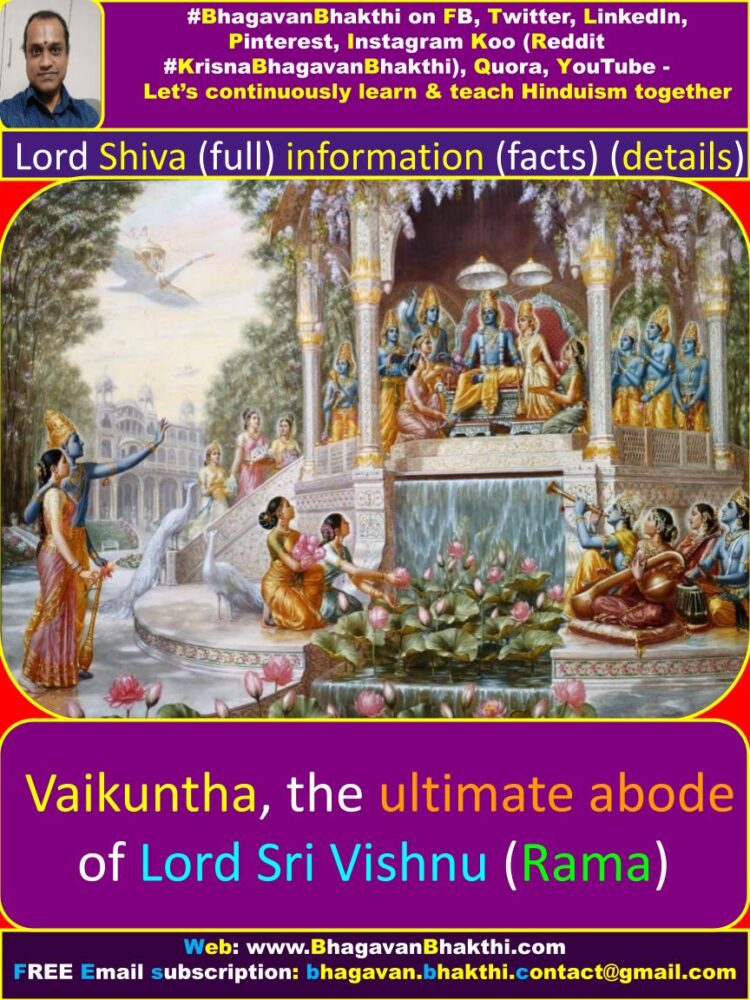
Prabhu Lord Sri Rama Chandra agreed and returned back to Vaikuntha after this situation.
Information about Lord Shiva’s boon to Drupada Maharaja is as given below:
Drupada Maharaja once did penance to Lord Shiva for getting a son. (Drupada Maharaja is the father of Draupadi Devi.)
Lord Shiva blessed him that he shall get a female baby and that the same shall become male subsequently. She is none other than Shikandi (Mahabharata Tatparya Nirnaya – adhyaya 11).
Information about Arjuna’s fight with Lord Shiva is as given below:
Arjuna, the Pandava archery great did penance to Lord Shiva and to his antaryami Lord Sri Vishnu at a place called Indrakeela.
After six months of penance Arjuna saw an asura (demon) named “Mukaasura (Mukasura)”, who came in the disguise of a pig.
Arjuna applied his arrows at the pig with his Gandiva bow. At the same time, Lord Shiva who came there in a disguised form of a kiraataka (man of the mountain tribe of the kirAtas) also hit at that asura (demon) with his arrow.
The asura (demon) who was in the disguise of a pig died with his real form (that is of demonic form).
Now, Lord Shiva disguised as a kiraataka told Arjuna that he had chased that pig first, but Arjuna had hit it first and thus Lord Shiva sked Arjuna to fight with him.
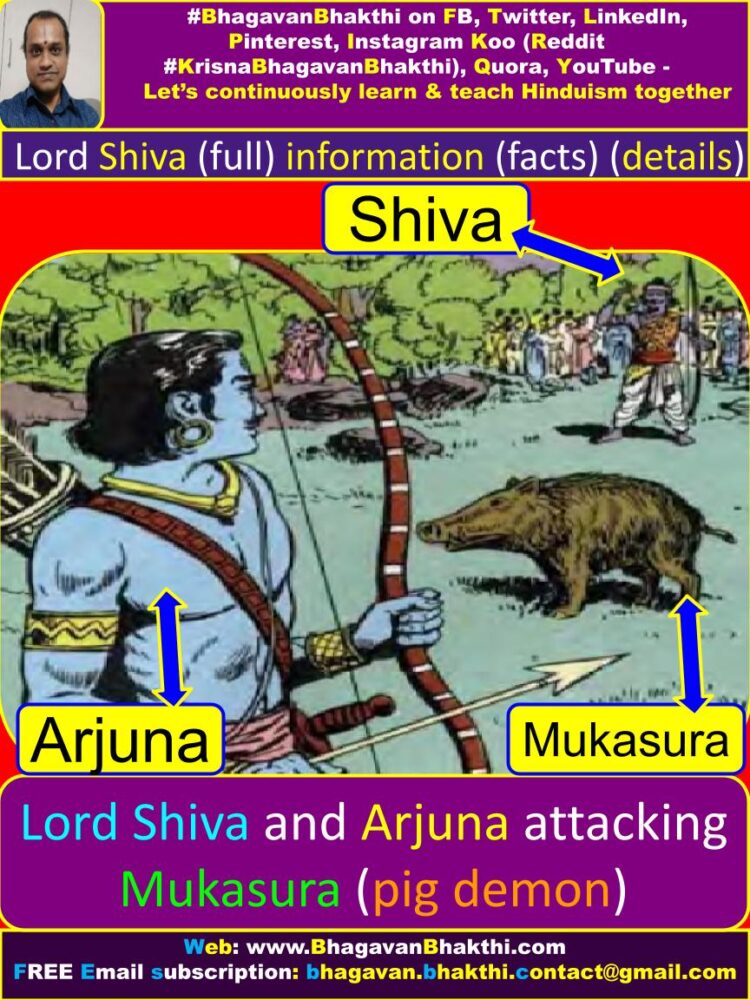
Arjuna agreed and the fight began between Lord Shiva and Arjuna. Lord Shiva swallowed all the arrows hit by Arjuna.
Now, Arjuna hit Lord Shiva with his Gandiva itself. Lord Shiva laughed at Arjuna and swallowed that Gandiva too. As such, the two started fighting in ‘Malla yuddhha‘ (wrestling). With the severe blows by Lord Shiva, Arjuna lost his consciousness and fell down.
Then after getting back his consciousness, Arjuna repented for having fought with that Kiraataka (Lord Shiva) and worshipped the Lord Shiva Linga nearby. The flowers decorated on that Linga by Arjuna were falling on that Kiraataka.
Pleased with the worship of Arjuna, Lord Shiva gave him Pashupatastra to Arjuna. (Mahabharata Tatparya Nirnaya adhyaya 22.143).
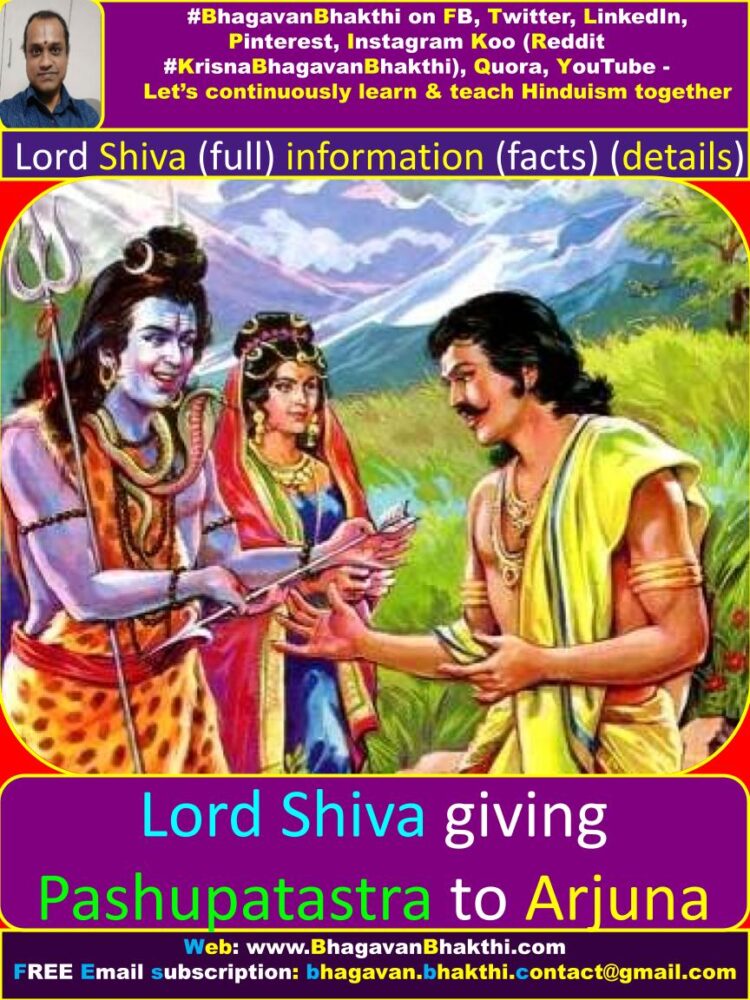
More information about Lord Shiva is as given below:
Lord Shiva has been worshipped since unknown time now. Lord Shiva’s worship is prevailing in Hindu Sanatana Dharma since time immemorial perhaps.
There are various historical and puranic references are present to the worship of Lord Shiva. We can find several divine personalities having worshiped Lord Shiva on different occasions for various reasons.
Lord Sri Vishnu in his various avatars also worshiped Lord Shiva for Loka Kalyanam (welfare of the ordinary people), Loka reetya (to teach how and why to worship Lord Shiva).
Now let us know the more and very important information about Lord Shiva as per our Hindu Sanatana Dharma (Hinduism).
Who is Lord Shiva? : Lord Shiva was born as the son of Lord Sri Brahma Deva from his mind and thus Lord Shiva is called as ‘manasa putra‘ of Lord Sri Brahma Deva.
[Brahma is a padavi / rank / position. Among all the jeevas (living beings, Lord Sri Brahma Deva is greatness. Please remember it is among all the jeevas / living beings. The Sarvottama / Supreme is Lord is Sri Vishnu.]
The present Lord Sri Brahma Deva’s original name is called as Virinchi (विरिन्ची (virin̄cī). Lord Shiva instantly emerged out (Sadhyojatha) from center of Lord Sri Brahma Deva’s eyebrows at the time of rachana / creation.
Soon after Lord Shiva took birth, he started cry and roar fiercely (Raudra) and hence called Lord Shiva is called as Rudra (Lord Sri Rudra Deva) (Rodanaat-Rudra).
[English word ‘roar’ has been originated from the Sanskrit word ‘raudra’ (रौद्र) (raudra).]
Lord Shiva is one of the Trinity Lords (Brahma-Vishnu-Maheshwara) ruling ‘Taamasa guna (Ahankaara Tattva)’. Lord Shiva is entrusted with the role of ‘Laya-karaka‘ (लयकारक) (layakāraka) (destruction) by Lord Sri Maha Vishnu.
Lord Shiva name meaning is as given here : Lord Shiva names means ‘mangalakara‘ (मंगळकर) (maṅgaḷakara) (auspicious), shubha (शुभ) (śubha) (highly propitious).
Lord Shiva who is incredibly and ever holy and thus Lord Shiva’s another name is Sadashiva. Sadashiva means pure, sacred and selfless.
Shambhu or Shambhuh name meaning is as given here : Lord Shiva is called ‘Shambhu or Shumbhuh‘ (शंभु or शंभुः) (śambhu or śambhuḥ), because he is full of bliss (Satyam-Shivam-Sundaram). This means, someone who bestows peace, prosperity and happiness.
Rudra name meaning is as given here : As Rudra or Maha Rudra, Lord Shiva is the eliminator of all agonies, sorrows, unhappiness, depression, misery, sadness, dejection, etc.
In Vishnu Sahasranama Stotram, we can find Lord Sri Vishnu is eulogized as Shiva and Rudra. In Bhagavad Gita-Vibhooti Yoga, Lord Sri Krishna says that “He is Shankara among the ‘Ekadasha Rudras“. (Here Ekadasha Rudra means eleven Rudras).
Also, Lord Shiva is popularly known as ‘Hara or Har‘, means, the one who destroys all the evil. Hara or Har (Haraye Namah) forms part of 24 Keshava namas (names) that we recite during ‘Aachamanam’.
Lord Shiva as Laya-kaaraka (लय-कारक) (laya-kāraka) is the ‘Maha Rudra’, that is, ‘Ugra’ / great destroyer, fearless.
Lord Shiva is ‘Shatru-Bhayankara’ (शत्रु-भयंकर) (śatru-bhayaṅkara), that is, someone who not only destroys creation as per directions of the supreme Lord Sri Vishnu, but also destroys both internal and external enemies and also provides cure for all diseases.
Lord Shiva is called as ‘Mahadeva’ (महादेव) (mahādēva) (great God). Though his ‘tattva’ is ‘Taamasa guna, Lord Shiva is ‘Satvika’ and serene in nature and worshiped by one and all irrespective of their temperament.
Lord Sri Vishnu also in different avatars, worshiped Lord Shiva for ‘Loka Kalyanam‘ (to teach to the ordinary people on how to worship Lord Shiva), welfare of the mankind and to maintain the Loka-reeti (local conventions).
Initially, Lord Shiva married Goddess Sri Sati Devi, that is, daughter of Daksha Prajapati. After the episode of Daksha Yajna, Lord Shiva gets married to Goddess Sri Parvati Devi (manifestation of one of the Goddess Durga).
Lord Shiva is also called as ‘Vaamadeva’ (वामदेव) (vāmadēva), which literally means the one who is very handsome, fair and pleasant.
Vaama also means left; and left side for any Purusha is the seat of female energy (Stree Shakti). Also, Lord Shiva will always be left of Lord Sri Vishnu; that’s why Lord Shiva is called ‘Vaamadeva‘.
It is very common to find Lord Shiva being worshiped in ‘Linga roopa’ (लिंग रूप) (liṅga rūpa) due to a curse from Maharishi (Sage) Bhrigu.
Since that time, ‘Shiva Linga‘ has become a symbol of Lord Shiva that is being worshiped in all the temples across the world. Lord Shiva’s abode is Mount Kailasha (Kailash), that is, ‘Kailasha (Kailash) Parvata‘.
Lord Shiva symbolism are as given below:
Even though Lord Shiva is worshiped in ‘Linga form’, Lord Shiva is depicted as the following:
Pure ‘suddha sphatika’ (white crystal clear) in colour | Lord Shiva always will be in meditative position | Lord Shiva has a gigantic form |
Lord Shiva will be wearing the skin of a tiger | Lord Shiva has dynamic and charming personality, that is as ‘Sundara’ | Lord Shiva is having serene looks in a yogic posture |
Lord Shiva’s body is smeared with Bhasma (white ash) with mendicant / detached demeanor having | Lord Shiva is called as ‘Trinetra’, as he is having three eyes.
Lord Shiva has Lord Sri Surya Deva (Sun God) in his right eye and Lord Sri Chandra Deva in his left eye and Agni in his third eye (middle) in between the eye brows.
Lord Shiva is having ‘Panchanana‘ (पंचानन) (pan̄cānana), that is, someone who is having five faces. Here Panchanana = Pancha + Anana = five + faces (heads).
The different names of Lord Shiva five faces are as given below:
Eeshaana (Ishana) (facing skyward) | Tatpurusha (facing east) | Aghora (facing south) | Vaamadeva (facing north) | Sadyojatha (facing west)
Lord Shiva has three eyes in each of his five faces as given above. Lord Shiva has long matter hairs (जटा) (jaṭā) spread in the vast sky (Vyomakesha) holding Lord Sri Vishnu’s ‘Padodbhavi‘ (पादोद्भवी) (pādōdbhavi) (born from the foot), that is –
Holy Ganga on his (Lord Shiva) head and thus Lord Shiva is also called as Gangadhara (Gangadhar) (गंगाधर) (gaṅgādhara).
Lord Shiva’s throat is blue in color and thus he is known as ‘Neelakantha / Neelagriva’ (नीलकंठ or नीलग्रीव) (nīlakaṇṭha or nīlāgrīvā).
(Here Neelakantha = Neela + Kantha= Blue + Throat. He is someone who is having throat in blue color.)
This name Neelakantha (Neelagriva) came when Lord Shiva drank the ‘haalaahala pashan’ (हालाहल) (hālāhala) (poison) during the ‘amrit manthan’ (amrita manthana) (अमृत मन्थन) (amr̥ta manthana).
Lord Shiva will always be adored with sarpa (serpent) around his neck. Thus Lord Shiva is called as ‘Naagashekhara / Sarpabhooshana’ (नागशेखर or सर्पभूषण) (nāgaśēkhara or sarpabhūṣaṇa).
[English word serpent has been originated / derived from this Sanskrit word Sarpa (सर्प) (sarpa).]
Lord Shiva has ‘Crescent Moon’ on his head and thus he is known as ‘Chandrasekhara or Somashekhara’ (चन्द्रशेखर or सोमशेखर) (candraśēkhara or sōmaśēkhara).
Lord Shiva’s vahana (vehicle or mount) is called as ‘Nandi’ and thus Lord Shiva is known as ‘Nandi Vahana’ (नन्दी वाहन) (nandi vāhana) and also known as ‘Vrishabha-Vahana’ (वृषभ-वाहन) (vr̥ṣabha-vāhana).
(Here Vrishabha-Vahana means a sacred divine Bull serving as vehicle or mount of Lord Shiva).
Lord Shiva is known as ‘Trishooladhari’ (त्रिशूलधारी) (triśūladhāri) (Holder of Trident), as he holds the ‘Trishoola’ (Trident) is his hand. This ‘Trishoola’ is also used as weapon by Lord Shiva.
Lord Shiva holds a small drum (Damaru) in his hand. And thus Lord Shiva is called as ‘Damarugadhari’ (डमरुगधारी) (ḍamarugadhāri).
Lord Shiva is always depicted as both a Yogi. And thus Lord Shiva is called as ‘Yogeshwara’ (योगेश्वर) (yōgēśvara).
Lord Shiva is also a ‘kutumbasta’ (कुटुंबस्त) (kuṭumbasta) (A householder) with Goddess Sri Parvati Devi, who is inseparable from Lord Shiva. The other two member of Lord Shiva family is Lord Ganesha and Lord Kartikeya.
Lord Shiva or Lord Sri Rudra Deva is also depicted as ‘Chaturbhuja’ (चतुर्भुज) (caturbhuja) (with four hands) having four hands.
Here Lord Shiva is depicting the first hand with ‘Varada mudra’ (वरद मुद्रा) (varada mudrā), in the second hand with ‘Abhaya mudra’ (अभय मुद्रा) (abhaya mudrā), holding ‘Trishoola’ (त्रिशूल) (triśūla) in the third hand and ‘Deer skin‘ in his fourth hand.
More information will be added to this on regular basis, please visit after some time to know more information.
To watch videos on #Hinduism #Sanskrit language, SUBSCRIBE to my YouTube channel from this link: #BhagavanBhakthi YouTube channel
Continue reading to know about “Lord Shiva (full) information (facts) (details) – Part 2 of 2” from this link: Lord Shiva (full) information (facts) (details) – Part 2 of 2
To know more names of Lord Shiva with meaning you can visit this link: Lord Shiva names with correct meaning
To know more information on Lord Shiva and Shivaratri, you can visit this link: Lord Shiva, Shivaratri, other significances
Dear friends, if you need any clarifications about this post, kindly let me know, I will definitely try to answer all of them.
Also your one LIKE, one COMMENT, One Share, one SUBSCRIPTION is highly important.
This will help to know the quality of this content and also it will be helpful to know if any improvements is required for the content.
If you feel this content is useful to you and has helped you to improve your knowledge, kindly share this with your well-wishers.
Because “SHARING MEANS CARING”.
To receive FREE EMAIL SUBSCRIPTION about #BhagavanBhakthi, you can send an email to bhagavan.bhakthi.contact@gmail.com from your email ID.
NAMASTE!
Sri Gurubhyo Namaha
Sri Krishnaaya Namaha
Sri Krishnaarpanamastu
Subscribe / Follow us Share in Social Media
I would like to thank you for the efforts you have put in penning this website. I really hope to view the same high-grade blog posts by you later on as well. In truth, your creative writing abilities has motivated me to get my own website now
Namaste,
Thanks for your valuable feedback. Please go through my other posts also. Keep in touch.
Shubhamastu!